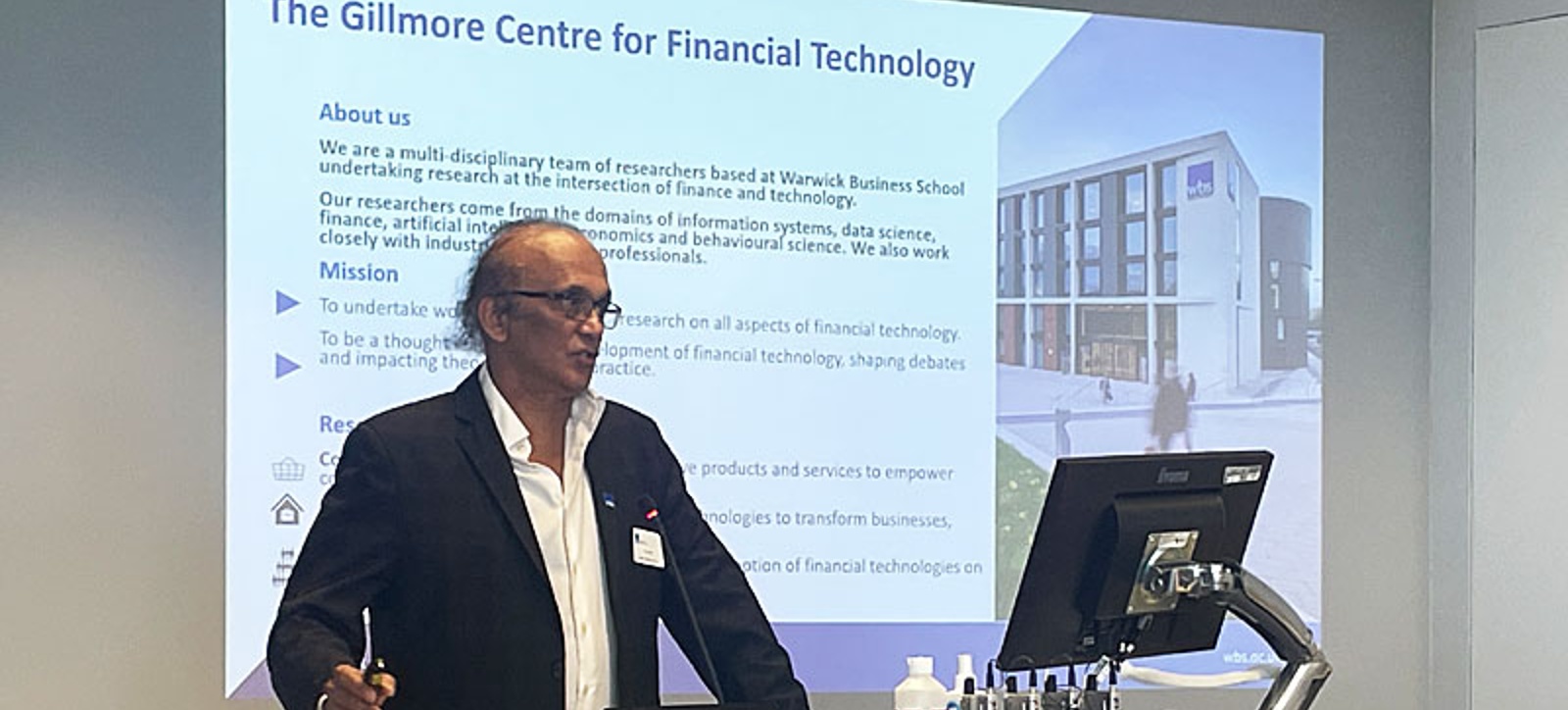
High-tech: Ram Gopal, Director of the Gillmore Centre of Financial Technology, opening the conference on DeFi and digital currencies at WBS London at The Shard
New research has revealed the US Federal Reserve’s monetary policy has limited influence on stablecoin lending rates, a conference at WBS London at The Shard heard.
In new research presented at Warwick Business School’s Gillmore Centre for Financial Technology’s Academic Conference on DeFi and Digital Currencies, Andrea Barbon, of the University of St. Gallen, studied 2.5 million transactions of US dollar-backed stablecoins on DeFi platform Aave.
Held at WBS London at The Shard, the conference saw representatives from the European Central Bank, the Bank for International Settlements (BIS), Banque de France and leading fintech academics from around the world attend. It heard researchers argue that the increasing popularity of stablecoins and Donald Trump’s new Genius Act that regulates the cryptocurrency means central banks should take notice of their influence.
The market capitalisation of stablecoins is already at $250 billion, but Professor Barbon says the Fed has a limited influence on their interest rates.
“Interest rates for stablecoins are very volatile,” said Professor Barbon. “Despite being pegged to the US dollar, stablecoins operate in a way that largely resist the traditional controls of the Federal Reserve.
“US monetary policy does influence stablecoin rates, but its effect is minimal, explaining only a limited portion of their variation. The majority of the volatility is driven by factors specific to the crypto ecosystem, particularly demand-driven shocks related to the desire for leverage to invest in other crypto assets like Bitcoin.”
Despite it being a digital currency, the research also found there was a lag in stablecoins' limited response to the Fed’s interest rate changes of several days and sometimes a week .
“This is an immature market with rates primarily driven by the volatile demand for leverage within the crypto ecosystem, which is not directly tied to traditional monetary policy,” said Professor Barbon. “As stablecoins grow and with the new Genius Act, central banks will need to have more oversight of the stablecoin market and its influence.”
The conference also saw research on the formation of bubbles in cryptocurrency prices by Maarten van Oordt, of Vrije Universiteit Amsterdam, and from BIS on the cross-border flows of Bitcoin, Ethereum, and stablecoins. There were also presentations on blockchain technology from the University of Bonn, Carnegie Mellon University, and George Mason University, plus a study on credit cycles in tokenised real estate markets by Daniel Ruf, of the University of Cambridge, and liquid staking on the Ethereum platform from Christine Parlour, of Haas School of Business, UC Berkeley.
Ram Gopal, Director of the Gillmore Centre for Financial Technology, said: “This conference has been a truly revealing experience, highlighting the complex and evolving dynamics where traditional finance meets the decentralised world of fintech.
“The groundbreaking research presented here, particularly on topics like the limited influence of central banks on stablecoin rates, is a testament to the fact that our work at the Gillmore Centre isn't just academic - it's actively shaping the global conversation around financial stability, policy, and innovation.
“It also influences what we teach on our new MSc Financial Technology course where leading academic research is aligned with industry best practices to give students the knowledge they need to succeed.”
Further reading:
What does the bitcoin inflation rate really mean?
AI bias: What can the Claude chatbot leak teach investors?
Why AI could transform peer-to-peer lending for investors
Learn more about fintech on the new MSc Financial Technology.
Discover more about fintech. Receive our Core Insights newsletter via email or LinkedIn.




 X
X Facebook
Facebook LinkedIn
LinkedIn YouTube
YouTube Instagram
Instagram Tiktok
Tiktok